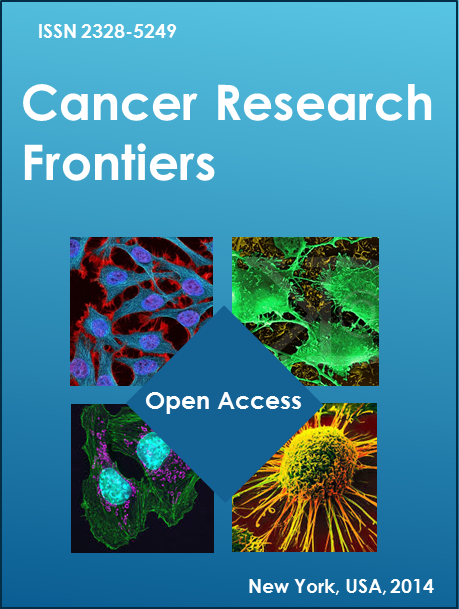Abstract _ Full Text (HTML) _ Full Text (PDF)
Review
Cancer Research Frontiers. 2015 Sep; 1(3): 225-236. doi: 10.17980/2015.225
Radiofrequency Ablation for the Local Treatment of Hepatocellular Carcinoma
Alvaro Martinez-Camachoa,b[*], Heather Laskeya, Blaze Cookb
a University of Colorado Denver, 12631 E. 17th Ave, MS B158, Aurora, CO 80045
b Denver Health Hospital and Authority, 660 Bannock St, MC 4000, Denver, CO 80204
[*]Corresponding author: Alvaro Martinez-Camacho, MD, Denver Health Hospital and Authority 660 Bannock St, MC 4000, Denver, CO 80204. Phone: 303-602-5032; Fax: 303-602-5055; Email:Citation: Alvaro Martinez-Camacho, et al. Radiofrequency Ablation for the Local Treatment of Hepatocellular Carcinoma. Cancer Research Frontiers. 2015 Sep; 1(3): 225-236. doi: 10.17980/2015.225
Copyright: @ 2015 Alvaro Martinez-Camacho, et al. This is an open-access article distributed under the terms of the Creative Commons Attribution License, which permits unrestricted use, distribution, and reproduction in any medium, provided the original author and source are credited.
Competing Interests: The authors declare that they have no competing interests.
Received April 8, 2015; Revised May 16, 2015; Accepted Jun 30, 2015.
Abstract:
Hepatocellular carcinoma (HCC) is the 3rd leading cause of cancer-related death worldwide, and the incidence of HCC is rising in the United States. Patients with cirrhosis of the liver and viral hepatitis are at the highest risk of developing HCC. Radiofrequency ablation has become an accepted first-line treatment for small HCC because of its similar outcomes when compared with surgical resection. However, local recurrence after radiofrequency ablation remains problematic and requires vigilant post-ablation surveillance imaging. Prior to radiofrequency ablation, the physician must take in to account tumor size and location as well as ability to obtain real-time imaging for a percutaneous approach, which is preferred. The procedure requires collaboration with an experienced interventional radiologist in order to obtain the best outcomes and minimize complications. Additionally, radiofrequency ablation can be used in combination with other treatment modalities, such as transarterial chemoembolization, to provide an adequate ablation bed for large tumors. Overall, the utilization of radiofrequency ablation should be part of the armamentarium of all physicians managing patients with HCC. This article reviews appropriate patient and tumor selection, advanced treatment techniques, complications, follow up, and post-treatment outcomes of radiofrequency ablation of HCC.
Keywords: Radiofrequency ablation, hepatocellular carcinoma, survival, recurrence, complication
Worldwide, hepatocellular carcinoma (HCC) is the 5th and 7th most common cancer in men and women, respectively (1). Furthermore, HCC is the 3rd leading cause of cancer-related death globally, with close to 700,000 deaths recorded in 2008. In the United States, HCC is the most rapidly increasing cause of cancer-related death and indication for liver transplantation (2-4).
SCREENING AND DIAGNOSIS
Cirrhosis of the liver is the most important risk factor for HCC. Because of this close association, the major hepatological societies recommend periodic screening with contrast-enhanced imaging for HCC in cirrhotic patients (5-8). The regional guidelines have notable differences which are highlighted in a recent review (9). Our center relies on a liver protocol CT; however, contrast-enhanced multiphase MRI or contrast-enhanced ultrasound may also be used. If HCC cannot be diagnosed on multi-phase imaging, then we perform a targeted liver biopsy. After a lesion is diagnosed as HCC, we recommend referral to a specialist in the treatment of HCC. Our center has a multi-disciplinary committee of hepatologists, surgeons, radiologists, interventional radiologists, oncologists, and palliative care physicians to help coordinate and provide care to patients with HCC.
STAGING AND TREATMENT ALGORITHMS
Numerous staging systems for HCC are available, including TNM, Okuda score, Barcelona Clinic Liver Cancer (BCLC) system, Cancer of the Liver Italian Program (CLIP), and others (10, 11). The American Association for the Study of Liver Disease has endorsed the use of the Barcelona Clinic Liver Cancer (BCLC) staging system, which includes assessment of the patient’s performance status, Child-Pugh classification, and underlying portal hypertension (12). The BCLC staging system is routinely used in our practice.
Treatment for HCC can be viewed as curative or palliative based on the BCLC staging system. Curative therapy for HCC has historically included surgical resection and, more recently, radiofrequency ablation (RFA) and orthotopic liver transplantation (OLT). Palliative therapy for HCC includes transarterial chemoembolization (TACE) and systemic chemotherapy with sorafenib. A relatively new modality for the treatment of HCC, microwave ablation, creates thermal destruction of tissue via a different mechanism than RFA that is less susceptible to the heat-sink effect (13). The role of microwave ablation in the routine treatment of HCC continues to evolve and will not be discussed in detail during this review.
Each patient discussed at our multi-disciplinary committee is evaluated using the BCLC staging system for potential curative therapy as the first step of assessment after the diagnosis of HCC. Our center relies on RFA to treat HCC that is not amenable to liver transplant or resection. This article will review the use of RFA for the treatment of HCC, with particular emphasis on appropriate patient and tumor characteristics, treatment of tumors in difficult locations, post-ablation survival, and complications associated with this treatment.
IMPORTANT CONSIDERATIONS PRIOR TO RFA
Thermal destruction of malignant tissue with minimal collateral injury to the hepatic parenchyma is the goal of RFA. Thermal destruction is achieved via delivery of electromagnetic energy in a closed-loop circuit that includes the radiofrequency generator, a monopolar needle electrode, and a large dispersive electrode (grounding pad). A more detailed physiologic description of RFA for liver tumors has been reported (14). Advantages of percutaneous RFA over a surgical approach are shorter length of hospitalization and fewer wound complications.
Two important issues should be considered when contemplating the use of RFA administered via a percutaneous technique. First, adequate real-time visualization of the HCC is necessary in order to achieve complete ablation as well as low rates of recurrence. Ultrasound, CT, and open MRI can be used to target the lesion during RFA (15). Our center uses real-time ultrasound imaging to identify target lesions for RFA. Ultrasound imaging can be hindered by small size of the lesion, especially in the setting of macronodular cirrhosis, and poor acoustic windows due to patient weight or tumor location (dome of the liver). The use of ultrasound contrast agents may be helpful to highlight lesions that are difficult to image, but their rapid washout from the tumor makes them of limited use intra-procedurally. The use of contrast agents for this indication has been described, but most contrast agents are not available for use in the United States (16). Additionally, contrast-enhanced ultrasound can be used immediately after RFA in order to determine the size of the ablation bed. We recommend caution using this technique as immediate post-RFA contrast-enhanced ultrasound examination frequently and significantly underestimated the size of the ablation bed compared to contrast-enhanced CT performed 24 hours later (29 mm vs. 35 mm, respectively; p<0.001) (17). Our center performs a two-stage strategy of lipiodol staining in order to improve visualization of liver lesions poorly defined by US and non-contrast CT. The first stage involves hepatic artery angiography with transarterial delivery of lipiodol, which may also be combined with TACE as per the discretion of the treating physician. The second stage is performed shortly thereafter using non-contrast CT to identify the area of lipiodol staining for percutaneous RFA. Figure 1a illustrates a patient with a large HCC that was not considered a candidate for hepatic resection or liver transplantation. This non-contrast CT clearly highlights with lipiodol the location of the HCC which was previously not seen with US or CT. Figure 1b shows the post-ablation appearance of the target HCC. Unfortunately, post-ablation follow-up for local recurrence after lipiodol staining is hindered by retention of lipiodol in the ablation bed. Note that the ablation bed is purposefully chosen to include a 1 cm margin around the lipiodol. Therefore, surveillance imaging must pay close attention to this non-enhancing rim to detect recurring lesions.
Another important factor to consider when contemplating the use of RFA is the ability to provide an adequate tumor ablation bed. It is widely accepted that a minimum of a 360 degree, 1 cm tumor-free margin is necessary for each ablation site. This degree of tumor-free margin is associated with a lower rate of local recurrence, as it accounts for under-sized tumor on pre-operative imaging and destruction of local microsatellite lesions. Older-generation needle electrodes and techniques could provide only an adequate tumor-free margin for lesions 2 cm and smaller. But newer electrodes, which include expandable multiple-tined designs or an overlapping ablation technique, and intra-procedural resistance monitoring allow for treatment of larger tumors up to 5 cm (18). Though these techniques have increased the effectiveness of percutaneous RFA for larger liver lesions, they are also associated with longer, more complex procedures that require frequent repositioning of electrodes under ultrasound guidance. A novel technique of RFA using a multiple-electrode switching system was developed to overcome the need for repeated repositioning of the electrodes and still allow for large ablation beds (19). This technique is particularly unique as it allows for impedance-assisted switching of current between 3 electrodes that maintains higher inter-electrode temperatures without frequent need of repositioning thereby allowing for more thorough coagulation necrosis of target tissue. A recent mid-term analysis using this technique revealed a large mean ablation volume was achievable (85 cm3) as well as lower rates of local tumor progression after 3 years of follow-up compared to standard RFA for HCC’s smaller than 5 cm (20).
|
PATIENT AND TUMOR CHARACTERISTICS TO CONSIDER
Before beginning RFA treatment of HCC, multiple characteristics of the patient and tumor must be taken into account. The main patient characteristics are performance status, comorbid conditions, and liver function. Our center utilizes the Child-Pugh classification system (21) to evaluate the liver function of potential RFA candidates, but it should be noted that no single test can perfectly assess the liver function. Patients with elevated bilirubin (>3.0 mg/dl), refractory ascites, resistant encephalopathy, or significant coagulopathy (INR > 1.5) should be approached with caution as their underlying liver disease may not tolerate the loss of liver parenchyma resulting from RFA. These same patient characteristics are considered contraindications to surgical resection. Our center typically excludes patients with Child-Pugh class C liver disease because their risk of death is higher from the underlying liver disease than from HCC if the tumor is small (<3cm). We evaluate patients with Child-Pugh class B liver disease on a case-by-case basis. Other patient factors, such as thrombocytopenia (<50 x 109 per liter), portal vein invasion, distant metastases, or multiple uncontrolled comorbidities should also be considered contraindications to RFA (22).
Tumor location is an important determinant in the overall feasibility of RFA (15). An HCC located near the hepatic hilum or gallbladder should be approached with caution due to the risk of thermal injury to the biliary system or gallbladder, which may result in leaks or strictures. We typically refer patients with these difficult-to-access tumors including those near the gallbladder to our surgeons for a laparoscopic approach, which can reduce the risk of thermal injury to adjacent structures. Advanced percutaneous techniques have been described for avoiding these structures, but they add considerable time and technical difficulty. For example, for lesions near the gallbladder fossa, the gallbladder may be displaced to prevent thermal injury by the use of 5% dextrose (hydrodissection) as described by Chen et al (23). Another case series showed that using intra-ductal chilled saline perfusion via a nasobiliary tube during RFA of an HCC located near the hepatic hilum reduced the risk of thermal injury to the biliary tree, but we have not used this technique (24). Another location of HCC that requires caution is the subcapsular site, sometimes referred to as an exophytic lesion. Treatment with RFA of subcapsular tumors carries the risk of thermal injury to adjacent gastrointestinal organs, the abdominal wall, or diaphragm and an increased risk of intra-peritoneal bleeding or tumor seeding. However, two case series reported an HCC located near peritoneal organs or the diaphragm may safely be treated with percutaneous RFA by use of an artificial ascites technique (25, 26). We have used the preceding advanced techniques when treating patients who were not amenable to a surgical approach due to associated comorbid conditions. Finally, ablation of an HCC that is adjacent to a large hepatic vessel (≥ 3 mm) is feasible, but should be approached with caution due to the heat-sink effect. The effectiveness of RFA to destroy tissue relies on achieving high tissue temperatures to induce coagulation necrosis. If a lesion is adjacent to a large vessel, then the ability to achieve the appropriate intra-lesional temperature is diminished. Therefore, the post-ablation tumor response should be monitored closely because of a risk of incomplete ablation from a heat-sink effect, which is a down-side limited to RFA. We use TACE followed by RFA to treat lesions adjacent to a large vessel because the embolization should theoretically reduce the heat-sink effect thereby increasing the tissue destructive effect of RFA. Alternatively, we have found that percutaneous ethanol injection (PEI) of the lesion adjacent to the vessel followed by RFA can provide an adequate ablation zone. Though not currently available in our practice, percutaneous microwave ablation is another technique that can destroy cancer tissue near a large vessel without combination therapies because it relies on a different mechanism to achieve thermal destruction of target tissues (27).
Tumor size and number are important when assessing a patient for RFA. There are no evidence-based recommendations for the limit in tumor size or number. However, the Cardiovascular and Interventional Radiological Society of Europe released guidelines in 2010 recommending that RFA be limited to a tumor size no more than 3cm (15). Two randomized controlled studies have demonstrated that RFA is as effective as and safer than hepatic resection for HCC smaller than 3 cm (28, 29). Data regarding medium-sized lesions (3-5 cm) are mixed and controversial, with a wide range in reported technical success (61-96%) (30-32). Therefore, the use of RFA of medium-sized lesions is at the discretion and experience of the operator. Tumors greater than 5 cm frequently cannot be completely ablated by any single technique or device; therefore, lesions larger than 5 cm should receive other treatment modalities or RFA in combination with other local therapies such as TACE (33, 34).
COMBINATION LOCAL THERAPY WITH RFA
Combination therapies of TACE or PEI with RFA were implemented in several small studies in order to improve the efficacy of local regional therapy. However, evidence-based criteria for use of combination therapy with RFA are not available. Our center typically relies on the use of TACE prior to RFA in the setting of large HCC (>3cm) or those lesions adjacent to large (> 3 mm) vessels. In both situations, there is a risk of incomplete ablation in a single session using RFA monotherapy. A prospective trial demonstrated that TACE prior to RFA in patients with an HCC between 3 to 5 cm was associated with a substantially lower local tumor recurrence (39% vs. 6%, p=0.012) after 3 years of follow-up when compared to RFA alone (34). The routine use of combination therapy of TACE with RFA for small lesions ≤ 3 cm was previously assessed as well (35). However, the authors demonstrated no additional benefit in terms of overall survival or recurrence with the addition of TACE leading them to conclude that the combined procedure should not be routinely used for this subgroup of patients with small HCC (<3 cm).
A combination of PEI followed by RFA was also studied in a single-center prospective trial to evaluate for any additional benefit. The researchers showed that the combination of PEI-RFA improved overall survival and lowered the rate of recurrence significantly when compared to RFA monotherapy in the sub-analysis of patients with HCC between 3 to 5 cm (36). No significant difference in overall survival was noted for smaller lesions (≤3 cm). In our practice, PEI is used to treat lesions adjacent to other vital structures to reduce the risk of collateral thermal damage.
Finally, a recent study evaluated the combination of TACE-RFA compared to TACE-microwave ablation for HCC’s and found no difference in the median progression free survival (21 vs. 22 months, respectively; p=0.32) and only a non-significant trend towards improved overall survival (23.3 vs. 42.6 months; p=0.10) (37). Ultimately, sufficient data to support the routine use of combined TACE-RFA or PEI-RFA for HCC is lacking. However, the combined therapy likely has a benefit in selected patients, particularly large (>3 cm) tumors or those near large vessels.
|
POST-ABLATION FOLLOW-UP
Contrast-enhanced imaging with CT or MRI is recommended immediately post-ablation and at 4-6 weeks after RFA in order to verify a complete technical response to therapy. Complete technical response is defined as lack of arterial enhancement in the area of previously diagnosed HCC. A peripheral rim of enhancement may be seen on the immediate follow-up image. A peripheral rim of enhancement on the immediate follow-up image is typically indicative of post-ablative changes (hyperemia due to inflammation) if it is relatively concentric and symmetric with a smooth inner surface (Figure 2). A peripheral rim of enhancement that is eccentric, asymmetric, and/or has a nodular inner surface is more suggestive of incomplete response or local recurrence of the HCC. Of course, comparison to pre-treatment imaging is critical and any suspected residual tumor should be addressed. Surveillance imaging is typically recommended at 3, 6, 9, and 12 months after the initial RFA to assess for local recurrence or de novo lesions (15). Thereafter, surveillance intervals may be lengthened to every 6 months (for 3 years) in patients without cirrhosis or life-long for patients with cirrhosis.
COMPLICATIONS
Percutaneous RFA is typically considered a low-risk procedure, but it is invasive and can be fatal. A meta-analysis that included randomized-controlled and observational studies described 11 deaths from 9,531 treated patients, giving a pooled mortality rate of 0.15% (38). The complications associated with these deaths included bile leak, peritonitis, tumor rupture with hemorrhage, colonic perforation, peritoneal hemorrhage, liver failure, and sudden death. This same meta-analysis found a major complication rate of 4.1% for RFA, where major complication was defined as an event that led to substantial morbidity, disability, increased level of care, or hospital admission or substantially lengthened hospital stay. The top ten reported major complications were tumor seeding, intra-peritoneal hemorrhage, hepatic abscess, ascites, pleural effusion requiring treatment, hepatic infarction, hepatic failure, perforation of a viscus lumen, and hemothorax.
Less frequently reported complications from RFA include localized skin burn at the site of the grounding pad, hypoxemia from sedation, subcapsular hematoma, cardiac tamponade, diaphragmatic hernia, pneumothorax, and bronchobiliary fistula (39-42). Finally, tumor seeding is a potential complication that is frequently feared though it is fortunately reported to occur infrequently (0.2-0.3% of cases) (43). Some centers have adopted a policy of ablation of the needle track to reduce the risk of tumor seeding.
Post-ablation syndrome, which typically includes symptoms such as fever, malaise, nausea, vomiting, and pain at the ablation site, should be discussed with each patient prior to RFA for HCC. The development of post-ablation syndrome is associated with larger ablation volumes or multiple tumors treated in a single session, however, symptoms of this syndrome can be present in up to one third of all patients undergoing RFA (43). Treatment of the symptoms is typically supportive and the syndrome will typically abate over a period of a few days. Symptoms that persist for more than 7 days and especially if progressive, should alert the provider to more ominous complications such as infection or biliary injury.
We routinely observe patients in the hospital for 24 hours after percutaneous RFA to monitor for these complications. Periodic assessment of vital signs including temperature, new or progressive symptoms, and abdominal and chest examination are important to identify developing complications. Post-ablation imaging can also help detect complications before the patient develops symptoms.
|
OUTCOMES AFTER RADIOFREQUENCY ABLATION: OVERALL SURVIVAL
Most studies that evaluated RFA treatment for HCC are retrospective cohort series, but a few small randomized controlled trials have been published. We remind the reader that the majority of HCC’s develop in patients with chronic liver disease. Therefore, survival is affected not only by the cancer but also by the degree of chronic liver disease. Furthermore, outcomes after RFA are usually compared with outcomes after hepatic resection or other ablative techniques and can include patients who receive first-line versus second-line therapy, combined therapy (e.g., in conjunction with TACE), and therapy of one versus more nodules. Therefore, comparison between studies is made difficult by the heterogeneity of the overall population. This section will highlight data from randomized controlled trials as well as results from large meta-analyses to provide insight into the utility of RFA for HCC.
Hepatic resection of a uninodular HCC is typically considered a first-line curative option for appropriately selected patients. In a large meta-analysis, 3 randomized controlled trials and 25 non-randomized studies comparing outcomes from RFA to hepatic resection, Wang et al. (44) analyzed the overall survival of 11,873 patients who received either RFA (n=6,094) or hepatic resection (n=5,779). The majority of the patients had Child-Pugh class A liver disease, which would have a lower impact on overall survival than would more severe liver disease. In analysis of three randomized controlled trials (Figure 3), the authors found that, for lesions up to 5 cm diameter, RFA and hepatic resection had similar 3-year overall survival rates (74% vs. 79%, OR 0.98, 0.74-1.29; p=0.87). However, in the meta-analysis of non-randomized studies, Wang et al. (44) demonstrated that RFA had an inferior overall survival compared to hepatic resection (75% vs. 83%, OR 0.67, 0.52-0.85; p=0.0008). The meta-analysis found that the quality of evidence was very low due to heterogeneity. It is possible that patients who were not ideal surgical candidates because of baseline characteristics such as large or bilobar lesions would preferentially receive RFA therapy, which would introduce a selection bias. Therefore, the authors performed a sub-analysis including only patients with tumor size less than or equal to 3 cm. In this sub-analysis, RFA and hepatic resection had similar overall survival rates at 3 years post-treatment. A similar analysis from the randomized controlled trials that included only patients with tumor size less than or equal to 3 cm found no difference in overall survival. Thus, these data suggest that RFA for hepatic lesions up to 3 cm in size in patients with well-compensated liver disease (Child-Pugh class A) has overall survival similar to that of hepatic resection.
Radiofrequency ablation has been compared to other forms of percutaneous ablation in smaller studies. A meta-analysis of 5 randomized controlled trials comparing RFA to PEI included 701 patients evenly divided between the two treatments (354 RFA; 347 PEI) (45). The majority of patients studied had a single, small HCC and Child-Pugh classification A. The overall survival at 3 years was significantly higher in patients treated with RFA than in patients treated with PEI (82% vs. 70%; risk difference 0.116, 95 % CI 0.06-0.17), and no major complications occurred with either treatment. A Cochrane database systematic review also documented superior overall survival (HR 1.64; 95% CI 1.31-2.07) for RFA compared to PEI with no overall difference in the rate of complications (46). Prior studies of PEI had shown its effectiveness in treating small tumors (<2 cm), but with significant reduction in effectiveness for larger tumors (47). PEI frequently requires 4-6 sessions in order to achieve complete ablation of a single lesion; thus, RFA is preferred over PEI due to better patient tolerability as well as superior overall survival outcomes.
The largest non-randomized, retrospective study comparing patients receiving RFA (n=85) to those receiving microwave ablation therapy (n=113) for HCC within Milan criteria found that local recurrence (5.2% vs. 10.9%, respectively) and overall survival at 3 years (82.7% vs. 77.6%, respectively) was statistically similar (48). Two other retrospective studies similarly reported equal rates of local recurrence and overall survival when comparing the two modalities (49, 50). Ultimately, local ablation of HCC with RFA appears to be comparable to microwave ablation in terms of rates of local recurrence and overall survival though studies directly comparing these techniques are limited in size.
|
RECURRENCE OF HCC
Recurrence of HCC is defined by evidence of arterial enhancement on contrast-enhanced imaging after RFA with a complete ablation (lack of arterial enhancement one month after therapy). Using this definition, recurrence of HCC may be due to incomplete ablation not detected on the initial follow-up image, interval growth from microsatellite disease that was previously missed, or de novo tumor growth in an at-risk liver with cirrhosis. Differentiation between these causes of recurrence may be difficult. In order to avoid inclusion of de novo tumors at a distant location, we here discuss findings where recurrence was defined as evidence of active tumor at or near the site of treatment.
In the 3 previously mentioned randomized trials comparing recurrence of HCC after RFA with that after hepatic resection, an equal rate 1 year after treatment was found (16% vs. 11%, p=0.19) (44). However, the recurrence rate for RFA became significantly higher at 3 years after treatment (43% vs. 29%; OR 1.48, 1.14-1.94) (Figure 4). Tumor recurrence in the non-randomized trials of the same meta-analysis demonstrated that RFA had a higher recurrence rate than did hepatic resection at 1 and 3 years after treatment (25% vs. 17% and 57% vs. 41%, respectively; p=0.03 and 0.004, respectively). A sub-analysis to control for selection bias that included only tumors less than 3cm found no significant difference in rate of recurrence at 1- or 3 years after treatment with RFA versus hepatic resection (13% vs. 15% and 51% vs. 45%, respectively; p=0.48 and p=0.94, respectively) (Figure 5). Again, selection bias, where patients with higher tumor burden or poor surgical candidates received RFA, is possible. Overall, the rate of recurrence after RFA when compared to hepatic resection is difficult to discern due to significant patient and tumor heterogeneity in the reported studies.
The meta-analysis of 5 randomized trials of RFA compared to PEI demonstrated a significantly reduced rate of local recurrence after 3 years in patients who received RFA therapy (22% vs. 7%) (45). Therefore, RFA should be considered superior to PEI because it not only can be accomplished with fewer sessions but has a lower recurrence rate. The aforementioned non-randomized study comparing RFA to microwave ablation found no significant difference in the rate of local recurrence (12% vs. 11%, respectively) at the treatment site (50). However, distant recurrence, defined by appearance of imaging evidence of HCC anywhere in the liver on follow- up imaging, was found in 65% of RFA-treated patients vs 81% microwave-treated patients after 5 years of follow up. A small randomized study comparing 48 patients who received RFA to 46 patients who received microwave ablation demonstrated a trend towards lower tumor recurrence in the RFA arm at 2 years after treatment (12% vs. 24%, respectively) (35). Firm conclusions comparing RFA and microwave ablation cannot be made because of a lack of larger randomized trials that assess overall survival and local recurrence after complete ablation.
We concede that tumor recurrence is an important consideration in the management of patients with HCC treated by RFA. The risk of tumor recurrence increases over time and likely is affected by the size and number of the initial tumor as well as the presence of underlying cirrhosis with viral hepatitis. Nonetheless, RFA of a small, uninodular HCC has comparable rates of survival to hepatic resection with lower rates of complications and should be considered an appropriate treatment option for carefully selected patients. We recommend post-RFA imaging surveillance with contrast-enhanced multiphase CT or MRI for detection of recurrent HCC so that recurrent lesions can be diagnosed and retreated early.
|
CONCLUSION
Newly diagnosed HCC is an increasingly common cause of cancers and of cancer-related death worldwide. As primary care doctors adopt societal screening guidelines these cancers are being found at an early stage, which means that more patients are candidates for potentially curative therapy. Optimal management of these patients requires a multi-disciplinary approach (gastroenterologist or hepatologist; radiologist, including interventionalist; oncologist; and surgical team). Orthotopic liver transplantation may cure not only the HCC but also the underlying cirrhosis. Unfortunately, donor organs for OLT remain scarce. Despite some limitations related to local tumor recurrence, RFA is an excellent alternative to OLT for patients who are candidates for potentially curative therapy. In appropriately selected cases, overall survival after RFA is high and similar to that of patients who undergo surgical resection. An exact estimate of local recurrence is difficult to discern due to large variability in the literature. Therefore, post-RFA imaging is recommended as surveillance for tumor recurrence. Overall, RFA should be a part of the armamentarium for physicians managing patients with HCC.
Abbreviations:
BCLC, Barcelona clinic liver cancer;
CLIP, Cancer of the liver Italian program;
CT, computed tomography;
HCC, hepatocellular carcinoma;
MRI, magnetic resonance imaging;
OLT, orthotopic liver transplantation;
PEI, percutaneous ethanol injection;
RFA, radiofrequency ablation;
TACE, transarterial chemoembolization.
Acknowledgement: The authors would like to thank Dr. Rajan Gupta (University of Colorado Hospital) for providing the CT and MRI images. No funding source was used by any author for this work.
References
- Ferlay J, Shin HR, Bray F, Forman D, Mathers C, Parkin DM. Estimates of worldwide burden of cancer in 2008: GLOBOCAN 2008. Int J Cancer. 2010 Dec 15;127(12):2893-917. DOI: 10.1002/ijc.25516.
- El-Serag HB, Mason AC. Rising incidence of hepatocellular carcinoma in the United States. N Engl J Med. 1999 Mar 11;340(10):745-50. DOI: 10.1056/NEJM199903113401001.
- El-Serag HB, Davila JA, Petersen NJ, McGlynn KA. The continuing increase in the incidence of hepatocellular carcinoma in the United States: an update. Ann Intern Med. 2003 Nov 18;139(10):817-23. DOI: 139/10/817 [pii].
- Ioannou GN, Perkins JD, Carithers RL, Jr. Liver transplantation for hepatocellular carcinoma: impact of the MELD allocation system and predictors of survival. Gastroenterology. 2008 May;134(5):1342-51. DOI: 10.1053/j.gastro.2008.02.013.
- Bruix J, Sherman M, American Association for the Study of Liver D. Management of hepatocellular carcinoma: an update. Hepatology. 2011 Mar;53(3):1020-2. DOI: 10.1002/hep.24199.
- European Association For The Study Of The L, European Organisation For R, Treatment Of C. EASL-EORTC clinical practice guidelines: management of hepatocellular carcinoma. J Hepatol. 2012 Apr;56(4):908-43. DOI: 10.1016/j.jhep.2011.12.001.
- Omata M, Lesmana LA, Tateishi R, Chen PJ, Lin SM, Yoshida H, et al. Asian Pacific Association for the Study of the Liver consensus recommendations on hepatocellular carcinoma. Hepatol Int. 2010;4(2):439-74. DOI: 10.1007/s12072-010-9165-7.
- Kamel IR, Bluemke DA. Imaging evaluation of hepatocellular carcinoma. J Vasc Interv Radiol. 2002 Sep;13(9 Pt 2):S173-84.
- Bota S, Piscaglia F, Marinelli S, Pecorelli A, Terzi E, Bolondi L. Comparison of international guidelines for noninvasive diagnosis of hepatocellular carcinoma. Liver Cancer. 2012 Nov;1(3-4):190-200. DOI: 10.1159/000343833.
- Pons F, Varela M, Llovet JM. Staging systems in hepatocellular carcinoma. HPB (Oxford). 2005;7(1):35-41. DOI: 10.1080/13651820410024058.
- Subramaniam S, Kelley RK, Venook AP. A review of hepatocellular carcinoma (HCC) staging systems. Chin Clin Oncol. 2013 Dec;2(4):33. DOI: 10.3978/j.issn.2304-3865.2013.07.05.
- Bruix J, Llovet JM. Prognostic prediction and treatment strategy in hepatocellular carcinoma. Hepatology. 2002 Mar;35(3):519-24. DOI: 10.1053/jhep.2002.32089.
- Yu H, Burke CT. Comparison of percutaneous ablation technologies in the treatment of malignant liver tumors. Semin Intervent Radiol. 2014 Jun;31(2):129-37. DOI: 10.1055/s-0034-1373788.
- Lencioni R, Crocetti L. Radiofrequency ablation of liver cancer. Tech Vasc Interv Radiol. 2007 Mar;10(1):38-46. DOI: 10.1053/j.tvir.2007.08.006.
- Crocetti L, de Baere T, Lencioni R. Quality improvement guidelines for radiofrequency ablation of liver tumours. Cardiovasc Intervent Radiol. 2010 Feb;33(1):11-7. DOI: 10.1007/s00270-009-9736-y.
- Masuzaki R, Shiina S, Tateishi R, Yoshida H, Goto E, Sugioka Y, et al. Utility of contrast-enhanced ultrasonography with Sonazoid in radiofrequency ablation for hepatocellular carcinoma. J Gastroenterol Hepatol. 2011 Apr;26(4):759-64. DOI: 10.1111/j.1440-1746.2010.06559.x.
- Meloni MF, Andreano A, Franza E, Passamonti M, Lazzaroni S. Contrast enhanced ultrasound: Should it play a role in immediate evaluation of liver tumors following thermal ablation? Eur J Radiol. 2012 Aug;81(8):e897-902. DOI: 10.1016/j.ejrad.2012.05.002.
- Dodd GD, 3rd, Frank MS, Aribandi M, Chopra S, Chintapalli KN. Radiofrequency thermal ablation: computer analysis of the size of the thermal injury created by overlapping ablations. AJR Am J Roentgenol. 2001 Oct;177(4):777-82. DOI: 10.2214/ajr.177.4.1770777.
- Lee JM, Han JK, Kim HC, Choi YH, Kim SH, Choi JY, et al. Switching monopolar radiofrequency ablation technique using multiple, internally cooled electrodes and a multichannel generator: ex vivo and in vivo pilot study. Invest Radiol. 2007 Mar;42(3):163-71. DOI: 10.1097/01.rli.0000252495.44818.b3.
- Woo S, Lee JM, Yoon JH, Joo I, Kim SH, Lee JY, et al. Small- and medium-sized hepatocellular carcinomas: monopolar radiofrequency ablation with a multiple-electrode switching system-mid-term results. Radiology. 2013 Aug;268(2):589-600. DOI: 10.1148/radiol.13121736.
- Friedman LS. Surgery in the patient with liver disease. Trans Am Clin Climatol Assoc. 2010;121:192-204; discussion 5.
- Shiina S, Tateishi R, Arano T, Uchino K, Enooku K, Nakagawa H, et al. Radiofrequency ablation for hepatocellular carcinoma: 10-year outcome and prognostic factors. Am J Gastroenterol. 2012 Apr;107(4):569-77; quiz 78. DOI: 10.1038/ajg.2011.425.
- Chen MH, Yang W, Yan K, Hou YB, Dai Y, Gao W, et al. Radiofrequency ablation of problematically located hepatocellular carcinoma: tailored approach. Abdom Imaging. 2008 Jul-Aug;33(4):428-36. DOI: 10.1007/s00261-007-9283-4.
- Ohnishi T, Yasuda I, Nishigaki Y, Hayashi H, Otsuji K, Mukai T, et al. Intraductal chilled saline perfusion to prevent bile duct injury during percutaneous radiofrequency ablation for hepatocellular carcinoma. J Gastroenterol Hepatol. 2008 Aug;23(8 Pt 2):e410-5. DOI: 10.1111/j.1440-1746.2007.05091.x.
- Kondo Y, Yoshida H, Shiina S, Tateishi R, Teratani T, Omata M. Artificial ascites technique for percutaneous radiofrequency ablation of liver cancer adjacent to the gastrointestinal tract. Br J Surg. 2006 Oct;93(10):1277-82. DOI: 10.1002/bjs.5374.
- Teratani T, Yoshida H, Shiina S, Obi S, Sato S, Tateishi R, et al. Radiofrequency ablation for hepatocellular carcinoma in so-called high-risk locations. Hepatology. 2006 May;43(5):1101-8. DOI: 10.1002/hep.21164.
- Liang P, Wang Y. Microwave ablation of hepatocellular carcinoma. Oncology. 2007;72 Suppl 1:124-31. DOI: 10.1159/000111718.
- Chen MS, Li JQ, Zheng Y, Guo RP, Liang HH, Zhang YQ, et al. A prospective randomized trial comparing percutaneous local ablative therapy and partial hepatectomy for small hepatocellular carcinoma. Ann Surg. 2006 Mar;243(3):321-8. DOI: 10.1097/01.sla.0000201480.65519.b8.
- Lu MD, Kuang M, Liang LJ, Xie XY, Peng BG, Liu GJ, et al. [Surgical resection versus percutaneous thermal ablation for early-stage hepatocellular carcinoma: a randomized clinical trial]. Zhonghua Yi Xue Za Zhi. 2006 Mar 28;86(12):801-5.
- Harrison LE, Koneru B, Baramipour P, Fisher A, Barone A, Wilson D, et al. Locoregional recurrences are frequent after radiofrequency ablation for hepatocellular carcinoma. J Am Coll Surg. 2003 Nov;197(5):759-64. DOI: 10.1016/S1072-7515(03)00750-6.
- Lee DH, Lee JM, Lee JY, Kim SH, Yoon JH, Kim YJ, et al. Radiofrequency ablation of hepatocellular carcinoma as first-line treatment: long-term results and prognostic factors in 162 patients with cirrhosis. Radiology. 2014 Mar;270(3):900-9. DOI: 10.1148/radiol.13130940.
- Lupo L, Panzera P, Giannelli G, Memeo M, Gentile A, Memeo V. Single hepatocellular carcinoma ranging from 3 to 5 cm: radiofrequency ablation or resection? HPB (Oxford). 2007;9(6):429-34. DOI: 10.1080/13651820701713758.
- Forner A, Llovet JM, Bruix J. Hepatocellular carcinoma. Lancet. 2012 Mar 31;379(9822):1245-55. DOI: 10.1016/S0140-6736(11)61347-0.
- Morimoto M, Numata K, Kondou M, Nozaki A, Morita S, Tanaka K. Midterm outcomes in patients with intermediate-sized hepatocellular carcinoma: a randomized controlled trial for determining the efficacy of radiofrequency ablation combined with transcatheter arterial chemoembolization. Cancer. 2010 Dec 1;116(23):5452-60. DOI: 10.1002/cncr.25314.
- Shibata T, Iimuro Y, Yamamoto Y, Maetani Y, Ametani F, Itoh K, et al. Small hepatocellular carcinoma: comparison of radio-frequency ablation and percutaneous microwave coagulation therapy. Radiology. 2002 May;223(2):331-7. DOI: 10.1148/radiol.2232010775.
- Zhang YJ, Liang HH, Chen MS, Guo RP, Li JQ, Zheng Y, et al. Hepatocellular carcinoma treated with radiofrequency ablation with or without ethanol injection: a prospective randomized trial. Radiology. 2007 Aug;244(2):599-607. DOI: 10.1148/radiol.2442060826.
- Ginsburg M, Zivin SP, Wroblewski K, Doshi T, Vasnani RJ, Van Ha TG. Comparison of combination therapies in the management of hepatocellular carcinoma: transarterial chemoembolization with radiofrequency ablation versus microwave ablation. J Vasc Interv Radiol. 2015 Mar;26(3):330-41. DOI: 10.1016/j.jvir.2014.10.047.
- Bertot LC, Sato M, Tateishi R, Yoshida H, Koike K. Mortality and complication rates of percutaneous ablative techniques for the treatment of liver tumors: a systematic review. Eur Radiol. 2011 Dec;21(12):2584-96. DOI: 10.1007/s00330-011-2222-3.
- de Baere T, Risse O, Kuoch V, Dromain C, Sengel C, Smayra T, et al. Adverse events during radiofrequency treatment of 582 hepatic tumors. AJR Am J Roentgenol. 2003 Sep;181(3):695-700. DOI: 10.2214/ajr.181.3.1810695.
- Loh KB, Bux SI, Abdullah BJ, Raja Mokhtar RA, Mohamed R. Hemorrhagic cardiac tamponade: rare complication of radiofrequency ablation of hepatocellular carcinoma. Korean J Radiol. 2012 Sep-Oct;13(5):643-7. DOI: 10.3348/kjr.2012.13.5.643.
- Nomura R, Tokumura H, Furihata M. Laparoscopic repair of a diaphragmatic hernia associated with radiofrequency ablation for hepatocellular carcinoma: lessons from a case and the review of the literature. Int Surg. 2014 Jul-Aug;99(4):384-90. DOI: 10.9738/INTSURG-D-14-00025.1.
- Kim YS, Rhim H, Sung JH, Kim SK, Kim Y, Koh BH, et al. Bronchobiliary fistula after radiofrequency thermal ablation of hepatic tumor. J Vasc Interv Radiol. 2005 Mar;16(3):407-10. DOI: 10.1097/01.RVI.0000150034.77451.6F.
- Mendiratta-Lala M, Brook OR, Midkiff BD, Brennan DD, Thornton E, Faintuch S, et al. Quality initiatives: strategies for anticipating and reducing complications and treatment failures in hepatic radiofrequency ablation. Radiographics. 2010 Jul-Aug;30(4):1107-22. DOI: 10.1148/rg.304095202.
- Wang Y, Luo Q, Li Y, Deng S, Wei S, Li X. Radiofrequency ablation versus hepatic resection for small hepatocellular carcinomas: a meta-analysis of randomized and nonrandomized controlled trials. PLoS One. 2014;9(1):e84484. DOI: 10.1371/journal.pone.0084484.
- Orlando A, Leandro G, Olivo M, Andriulli A, Cottone M. Radiofrequency thermal ablation vs. percutaneous ethanol injection for small hepatocellular carcinoma in cirrhosis: meta-analysis of randomized controlled trials. Am J Gastroenterol. 2009 Feb;104(2):514-24. DOI: 10.1038/ajg.2008.80.
- Weis S, Franke A, Mossner J, Jakobsen JC, Schoppmeyer K. Radiofrequency (thermal) ablation versus no intervention or other interventions for hepatocellular carcinoma. Cochrane Database Syst Rev. 2013;12:CD003046. DOI: 10.1002/14651858.CD003046.pub3.
- Lencioni R. Loco-regional treatment of hepatocellular carcinoma. Hepatology. 2010 Aug;52(2):762-73. DOI: 10.1002/hep.23725.
- Ding J, Jing X, Liu J, Wang Y, Wang F, Wang Y, et al. Comparison of two different thermal techniques for the treatment of hepatocellular carcinoma. Eur J Radiol. 2013 Sep;82(9):1379-84. DOI: 10.1016/j.ejrad.2013.04.025.
- Vogl TJ, Farshid P, Naguib NN, Zangos S, Bodelle B, Paul J, et al. Ablation therapy of hepatocellular carcinoma: a comparative study between radiofrequency and microwave ablation. Abdom Imaging. 2015 Jan 20. DOI: 10.1007/s00261-015-0355-6.
- Zhang L, Wang N, Shen Q, Cheng W, Qian GJ. Therapeutic efficacy of percutaneous radiofrequency ablation versus microwave ablation for hepatocellular carcinoma. PLoS One. 2013;8(10):e76119. DOI: 10.1371/journal.pone.0076119.













